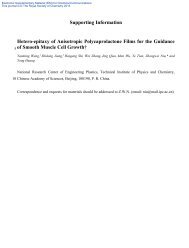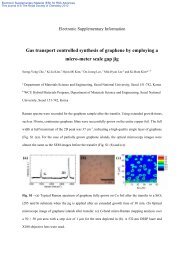Press Release: Dress of Glass and Flame - Royal Society of Chemistry
Press Release: Dress of Glass and Flame - Royal Society of Chemistry
Press Release: Dress of Glass and Flame - Royal Society of Chemistry
You also want an ePaper? Increase the reach of your titles
YUMPU automatically turns print PDFs into web optimized ePapers that Google loves.
Cont…<br />
For the Biennale, Helen was been drawn towards the chemistry <strong>of</strong> both glass <strong>and</strong> flame, <strong>and</strong> wanted to<br />
create a work within which a part <strong>of</strong> the original creative <strong>and</strong> alchemic process could be kept ‘alive’.<br />
The chemistry behind the ‘<strong>Dress</strong> <strong>of</strong> <strong>Glass</strong> <strong>and</strong> <strong>Flame</strong>’ by Pr<strong>of</strong> Tony Ryan:<br />
<strong>Glass</strong>: The thing we know as glass is in itself a mystery. At the atomic <strong>and</strong> molecular level it looks like a<br />
liquid, the atoms are close together but arranged at r<strong>and</strong>om, but in our h<strong>and</strong>s we know it is a brittle solid.<br />
The answer to this paradox is that the atoms are moving very slowly, so slow that we break the bonds<br />
before the material can flow. When a glass gets hot it acts like a rubber or a viscous liquid, depending<br />
on the internal bonds, <strong>and</strong> we can permanently change its shape. It is this property that allows us to<br />
make intricate shapes from glass.<br />
The most common glass is made from s<strong>and</strong> or silica, silicon dioxide, SiO2. This was the first glass<br />
discovered as beads in the embers <strong>of</strong> a very hot fire more than 4000 years ago. Most modern soda-lime<br />
glass (for windows <strong>and</strong> bottles) has other ingredients added to make it workable at temperatures lower<br />
that the 1200 C required for pure silica. Soda-lime glass is very brittle <strong>and</strong> can <strong>of</strong>ten crack on cooling<br />
because <strong>of</strong> its high thermal expansion, so Pyrex glass was invented by Dow-Corning in 1915 to get<br />
around this problem. It contains boron <strong>and</strong> is known as borosilicate glass. It was a development <strong>of</strong><br />
other thermal shock-resistant glasses <strong>and</strong> finds widespread use as both laboratory glassware <strong>and</strong> for<br />
cooking. The “py” in Pyrex® is really a pie, as the first commercial use was to make a pie-dish.<br />
<strong>Flame</strong>: A flame is a magical dancing chemical reaction. It is the visible, gaseous part <strong>of</strong> a fire. It is<br />
caused by a highly exothermic reaction, taking place in a thin zone <strong>and</strong> the heat is so intense it excites<br />
the molecules enough to produce light. Colour <strong>and</strong> temperature <strong>of</strong> a flame depend on the fuel involved<br />
in the combustion.<br />
Just think about lighting a c<strong>and</strong>le. The applied heat causes the fuel molecules in the c<strong>and</strong>le wax to<br />
vaporise. In this state they can then readily react with oxygen in the air, which gives <strong>of</strong>f enough heat in<br />
the exothermic reaction to vaporise yet more fuel, thus sustaining a consistent flame. The high<br />
temperature causes the molecules to decompose, forming various incomplete combustion products <strong>and</strong><br />
free radicals. The intense energy in the flame will excite the electrons in some <strong>of</strong> the transient reaction<br />
intermediates resulting in the emission <strong>of</strong> visible light as these substances release their excess energy.<br />
And you can use the colour <strong>of</strong> a flame to estimate the temperature.<br />
Exhibition:<br />
May 31 - November 24, 2013<br />
<strong>Glass</strong>tress: White Light / White Heat<br />
Contemporary artists <strong>and</strong> glass<br />
Collateral Event <strong>of</strong> the 53rd International Art Exhibition – La Biennale di Venezia<br />
On its return to London in November, <strong>and</strong> following display at a yet to be announced venue, the dress<br />
will be highlighted in the <strong>Royal</strong> <strong>Society</strong> <strong>of</strong> <strong>Chemistry</strong>’s programme <strong>of</strong> public outreach activities in 2014<br />
<strong>and</strong> is expected to tour to various locations around the UK <strong>and</strong> to science festivals.<br />
For more information, including ‘works in progress’, please see: dress<strong>of</strong>glass<strong>and</strong>flame.org<br />
rsc.org<br />
helenstoreyfoundation.org<br />
glasstress.org<br />
sustainable-fashion.com<br />
shine.sheffield.ac.uk<br />
Twitter: @Pr<strong>of</strong>HelenStorey















